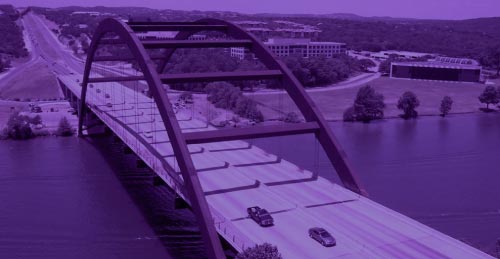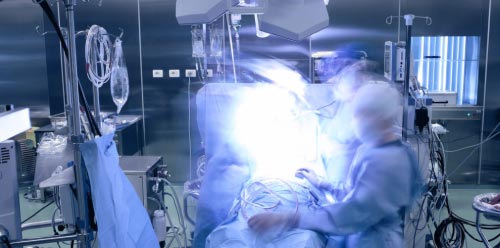INDUSTRIES WHERE FIBER OPTIC SENSOR TECHNOLOGY IS USED
Fiber Optic Sensor Technology: Overview
Sensuron’s distributed strain and temperature sensing technology uses light across thousands of sensors to test and measure both the integrity of materials and improve the safety and performance of systems across industries.
By utilizing Sensuron systems, engineers can collect and analyze material and structural data in demanding environments. This helps to solve problems on a global scale and encourages the sustainable development, operation, and maintenance of equipment.
Sensuron’s Fiber Optic Sensing Technology Options Are Endless
Sensuron’s systems are used in:
- Aircraft – Monitor structural changes to aircraft in real-time while in flight
- Aerospace Launch Vehicles – Test temperature, strain, load, 2D deflection, and cryogenic liquid levels
- Satellites – Monitor the structural health of satellites
- UAV Testing – Monitor the lifecycle and stability of UAV components and equipment
- End-Of-Life Testing – Determine whether an aircraft is reaching end-of-life
- Automotive – Frame analysis for improved safety and handling
- Future Innovations – Influence future structural designs
- Fuel Consumption – Optimize structures to reduce weight
- Medical Procedures – Improve minimally invasive procedures
- Medical Devices – Monitor movement and placement of catheters, endoscopes and other surgical tools
- Structural Health Monitoring – Monitor the position and structural health of components, risers and rigs
- Nuclear Power Plants – Monitor the structural health of power plant components
- Renewable Energy – Wind turbine blade feedback control, load monitoring, and structural health monitoring
FIBER OPTIC SENSORS IN AEROSPACE APPLICATIONS

Stress and strain are the parameters that determine the longevity and operational safety of any flight-bound vehicle.
With thousands of sensors contained in a single hair-thin fiber providing these measurements, Sensuron’s fiber optic solutions provide a detailed picture of the health of an aircraft.
Sensuron enables engineers to test, monitor and analyze the integrity of structures and capture aircraft component positioning feedback through the continuous monitoring of strain, temperature, stress, loads, out-of-plane deflections, and three-dimensional shapes.
Armed with this data, engineers can create innovations that transform industries, improve safety, prolong the life cycle, reduce maintenance, and enhance in-flight efficiency of aircrafts – all resulting in reduced costs.
By providing a comprehensive picture of an aircraft’s health and performance, Sensuron’s technology ensures continuous innovation as well as the safe transportation of people and equipment around the world and into space.
- Physical Changes – Test, monitor and analyze the integrity of aircraft components against physical factors such as vibration, shock and extreme temperature
- Operation – Provide in flight information on actual flap and landing gear position
- Lifecycle Updates – Monitor the lifecycle and stability of critical components and substructures.
- Long-Term Changes – Determine exactly how loads redistribute as an aircraft ages or becomes damaged
- Safety – Enhance safety margins for mission success
Examples
- Minimize aircraft downtime and fine-tune maintenance schedules
- Improve fuel consumption through intrinsically safe fuel level measurement
- Monitor the shape of the wing and other deformed components
- Determine when an aircraft is reaching end-of-life
- Understand the response of complex airframes to flight conditions
- Provide in-flight feedback to control systems
Sensuron Advantages
- 2D deflection
- 100 Hz refresh rate
- 3D shape sensing
- Simultaneous interrogation of all channels
- Significantly more sensors
- Lightweight
- Ruggedized
- Ultrafine spacial resolution
- Embeddable
APPLICATIONS
ADDITIONAL APPLICATIONS
- Structural Health Monitoring – Unparalleled measurement capabilities and reliable assessment method of structural integrity
- Composite Embedment – Ensure composite manufacturing quality
- Cryogenic Tank Monitoring – Fully operational in extreme temperatures for fuel volume detection
- Flight Control Systems – Real-time monitoring and feedback
- Design Verification – Expansive coverage from sub-component to full-scale tests
- Conforming Wings
- Landing Gear
- Design Validation
- Quality Assurance
- Load Monitoring
- Flight Testing
- Ice Detection
- Magnetic Field
FIBER OPTIC SENSING IN CIVIL ENGINEERING & MINING APPLICATIONS

An aging infrastructure and rapidly growing technical advances have inspired new trends in civil engineering, such as mixed reality, UAV data analysis, and a bigger push for 3-D models.
Regardless of these trends, functionality and safety are still the primary drivers of sound construction, and mounting pressure continues to rest on civil, structural, and mechanical engineers to focus on design excellence.
From static testing of small components to fatigue testing of full-scale structures, Sensuron’s distributed sensing technology has transformed and evolved the methods used to conduct design validation and ongoing structural testing.
Using Sensuron’s distributed strain sensing technology, a single optical fiber provides an unprecedented level of insight into the behavior of a structure, enabling engineers to perform comprehensive model validation at thousands of discrete points.
This one-of-a-kind technology shows engineers precisely what happens over a continuous sensing length, and allows them to acquire high-resolution and highly granular data in real time.
The result is extremely accurate FEM validation as well as dependable ongoing structural health monitoring.
FIBER OPTIC SENSORS IN ENERGY APPLICATIONS

The energy industry is changing. Oil and gas resources are becoming increasingly difficult to access, while renewable technologies grow evermore critical to new energy solutions.
Companies are continuously searching for new and innovative ways to optimize production.
Sensuron’s optical sensing platform provides engineers with accurate, comprehensive views of strain fields, 3D shape, liquid level, temperature distributions, and more.
Sensuron’s technology embeds thousands of continuously distributed sensors along EMI-immune and chemically inert glass fibers. This unique ability ensures maximum coverage in even the most harsh and demanding environments.
Sensuron’s groundbreaking technology gives engineers an extra edge in their efforts to keep people safe, optimize production, and reduce costs.
- Electromagnetic Immunity – Immune to electromagnetic interference
- Environmental Integrity – Operates in harsh environments: -200 to 200 C, chemically inert
- More Data – Distributed profiles rather than discrete points for a more comprehensive picture
- Real-Time – Accurate strain, temperature, liquid level, and pressure data in real time
- Simplicity – Bypasses cumbersome and heavy wiring harnesses required by other sensors
Examples
- Maximize integrity of risers and rigs
- Provide control system feedback for wind turbine blades based on deflection and rotation
- Monitor the structural integrity of wind turbine blades
- Sense nuclear power plant component structural health and alignment
Sensuron Advantages
- Significantly more sensors (16,000+ on RTS125+)
- Simultaneous interrogation of multiple fibers
- 3D shape sensing
- 2D deflection
- Liquid level
- Dynamic events
APPLICATIONS
- Wind Turbine Structural Health Monitoring – Blade deflection and load monitoring
- Rig Platform Structural Integrity Monitoring – Stress and strain monitoring and detection
- Tank Structural Integrity – Monitor pressure vessels in real time
ADDITIONAL APPLICATIONS
- Shape Sensing
- Well Casing Sensors
- Pressure Vessel Monitoring
- Generator Temperature Distribution
FIBER OPTIC SENSING IN AUTOMOTIVE APPLICATIONS

As the automotive industry makes the transition from steel to composites and other advanced lightweight materials, engineers are facing new design challenges.
Sensuron’s distributed sensing platforms can help remove uncertainty from designing with new materials.
By obtaining spatially continuous data along the entire length of an optical fiber, Sensuron’s technology provides engineers with accurate, comprehensive views of strain fields, 3D shape, liquid level, temperature distributions, and more.
All of these parameters can measured simultaneously and in real time. This unique ability ensures maximum coverage of an application and the flexibility to resolve challenges across automotive organizations.
- Multi-Sensing – Simultaneously sense multiple parameters
- Robust Platform – Replace multiple sensing systems with a single platform
- Fully Distributed Sensing – Spatially continuous measurements for a more comprehensive picture
- Better Data – Multiple times more data than conventional sensing technologies
Examples
- Having access to better data empowers engineers to detect design flaws earlier in product development, preventing costly failures after a product is launched. This ensures resources can be intelligently invested in projects that will be successful
- Legacy sensing technologies require a significant amount of time and expertise to install. Sensuron’s technology can be installed in less than one third of the time
- Standard data collection platform so dynamic and static tests can be conducted in a variety of environments
- Improve organizational efficiency be replacing multiple sensing technologies with a single Sensuron platform
Sensuron Advantages
- Multi-sensing
- Dynamic testing
- 16-104m of sensing length
- Rugged platform
APPLICATIONS
ADDITIONAL APPLICATIONS
- Monitor Body Panels – Simultaneously monitor deformation, temperature, strain fields and more
- Static or Dynamic Testing – Test components to check for fatigue over time
- Chassis Characterization – Characterize composite and metal chassis in static or dynamic environments
- Model Validation – Optimize design and safety components and assemblies through model validation
- Measure Temperature Distributions – Exhaust system, engine room, radiator, break pads and more
- Characterize Materials
- Composite Embedment
- Rigidity Testing
- Seat Deflection Monitoring
OPTICAL FIBER SENSORS IN MEDICAL APPLICATIONS

Minimally invasive procedures and the associated tools and devices are becoming increasingly relied upon across the healthcare industry.
Existing magnetic resonance imaging (MRI) techniques are often restricted by the performance of electronic sensors, and catheter tracking devices aren’t providing a detailed enough picture of the location of delivered medicines and surgical sites.
Such shortcomings leave medical professionals unable to monitor the patient or device as closely as needed.
Whether as an independent sensor or part of an integrated component, Sensuron’s fiber optic sensing systems can provide more detailed and reliable feedback for these types of procedures.
Sensuron’s thin, flexible, high sensor density fiber optic technology provides information continuously along the entire length of a surgical instrument without the use of X-rays or ultrasound.
The technology enhances precision so surgery times can be decreased and the amount of imaging agents can be minimized.
3D location measurements can be plotted in real-time and displayed visually to provide surgeons with an accurate and instant view of an instrument’s position.
Sensuron’s sensing platforms equip engineers with the tools needed to create the next generation of minimally invasive surgical instruments.
The technology increases the probability of success and leads to safer, repeatable and effective healthcare methods.
This reduces the risk of complication during procedures and enables quicker recovery, thus improving long-term health for patients and decreasing the length of hospital stays.
- MRI – Magnetic resonance compatible
- 3D View – Three-dimensional positioning, temperature, pressure
- Real Time – Real-time data
- Small Size – Small diameter (200 micro meters) makes it ideal for minimally invasive procedures
- More Sensors – Distributed sensing capabilities
Examples
- Improved imaging technology in MRI systems
- Assistance with vascular procedures as well as detection to identify the severity of an artery blockage
- Determine shapes of objects during minimally invasive surgeries and probes
- Enable higher resolution instrument tracking while minimizing the complexity associated with traditional imaging methods
- Minimizes the injection of foreign material into the body
Sensuron Advantages
- High refresh rate
- High resolution and accurate 3D shape sensing
- High density of sensors in a single fiber
APPLICATIONS
- Catheter Shape Sensing – Monitors placement and movement
- Robotic Tool Position Sensing – Performance precision and real-time feedback
- Monitoring Body Mechanics – Accurately determine the shape of the path in 3D
- Swallowing Diagnostics – Uses strain and 3D sensing
ADDITIONAL APPLICATIONS
- Device Positioning
- Fractional Flow Reserve Catheter
- Bone Mechanics
Feel free to download some of our case studies and white papers.
